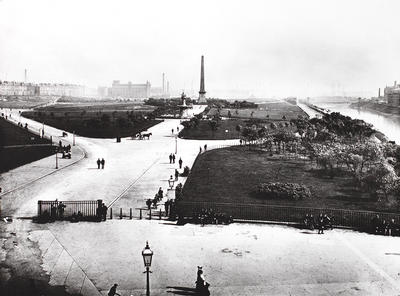
Glasgow Green looking east from the Justiciary Courts buildings, 1904. The River Clyde (crossed by the St Andrew's Footbridge) is on the far right and the Nelson Monument (erected 1806) in the centre distance, behind the Doulton Fountain (erected 1890).
The Green covered 136 acres by 1904. Traditionally, it was used for grazing cattle and washing and bleaching clothes, and it was the site of the annual Glasgow Fair. In 1746 Prince Charles Edward Stuart reviewed his Jacobite troops on the Green, and it remained the most favoured location in the city for army and militia parades and exercises, as well as for political and religious meetings and demonstrations. In the 1820s, however, the first carriage roads and footpaths were built as the old common land was laid out as a public park. Statues, drinking fountains, children's playgrounds and other features, were added during the 19th century. The Fair moved to Vinegar Hill in 1871.
Reference: Glasgow University Archive Services, PHU64/37
University of Glasgow
Keywords:
carriage roads, Doulton Fountain, fairs, footbridges, footpaths, fountains, Glasgow Fair, Glasgow Green, James Templeton & Co, monuments, Nelson Monument, parks, St Andrew's Footbridge, suspension bridges, Templeton's Carpet Factory
You have 1 image in your photo album.